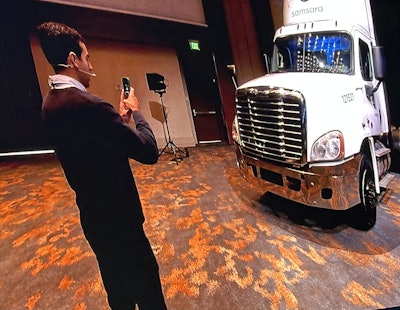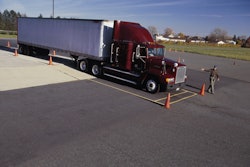
A Freightliner semi with a flat tire sat in the ballroom of a bayfront hotel in San Diego as Max Rencoret showcased one of Samsara’s latest developments in artificial intelligence.
Rencoret, Samsara’s vice president of product management - Connected Forms, performed a Driver Vehicle Inspection Report (DVIR) in the Samsara app Tuesday during the annual Samsara Beyond conference. He tried to beat the system by uploading an old photo from his camera roll, but the AI detected it. He tried taking a picture of the back of the truck, but the AI detected that it wasn’t the front of the vehicle. All of these AI detections force the driver to perform a proper DVIR.
“The No. 1 thing we hear from many of you is you want to make sure drivers actually walk around the vehicle,” he said.
When Rencoret opened the DVIR on the Samsara driver app, it automatically detected his location to confirm he was next to the vehicle. The feature also converts inspection notes from voice to text. The platform triggers real-time alerts for missing DVIRs, monitors Federal Motor Carrier Safety Administration (FMCSA) data, reviews inspection results and audits driver behavior.
“Sometimes drivers are in a hurry. They might take some shortcuts, and instead of getting out of the vehicle, performing that walkaround inspection, sometimes they get pencil whipped from inside the cab,” said Samsara Chief Product Officer Kiren Sekar. “We try to find ways around that like requiring the driver to take photos, and sometimes you then find photos of a driver's shoes and the bottom of the truck floor. This is an industrywide problem.”
This feature is designed to change that.
Sekar said DVIR has become the No. 1 workflow on the platform with its customers’ drivers collectively completing a quarter of a billion DVIRs every year.
DVIR is just one of Samsara’s new preventative maintenance features. The company also introduced fault code intelligence and automated work orders.
All of these are designed to help fleets reduce vehicle downtime and potential financial penalties, as 60% of all Department of Transportation offenses are comprised of vehicle maintenance violations, according to the FMCSA.
Fault code intelligence and automated work orders extends to the back office, where fleet administrators can view DVIRs alongside the vehicle maintenance status of those specific trucks.
Sekar showed the dashboard where the flat tire defect was logged in Rencoret’s DVIR. The dashboard also showed fault codes on that truck. Samsara’s new fault code intelligence feature automatically deciphers the codes and uses AI to create maintenance work orders.
 Samsara Chief Product Officer Kiren Sekar demonstrates Samsara's maintenance dashboard.Angel Coker Jones
Samsara Chief Product Officer Kiren Sekar demonstrates Samsara's maintenance dashboard.Angel Coker Jones
“Many of you are getting tens of thousands of fault codes across your fleet every single month, and it can be very challenging to figure out which are the important ones that you need to act on,” Sekar said. “This is another great application for AI.”
He opened one of the fault codes, and the AI interpreted it.
The code pertained to the after-treatment system, and the AI highlighted it as a high-priority, noting the risks of potential regulatory implications and vehicle performance impact if the vehicle continued to operate with this fault.
The AI also explained how to troubleshoot and repair the issue, and if the user has additional questions, the Samsara assistant can provide further guidance. For example, it could share what tools a mechanic would need to make the repair. All of this is based on the context of this vehicle and its history, repair manuals and information about this fault code.
“At this point, traditionally, we would move outside of the Samsara platform into our third-party maintenance application,” Sekar said.
While some fleets have access to high-quality maintenance software, he said many are still operating in legacy systems that are difficult to use and lack the data and intelligence to help fleets understand and optimize maintenance programs.
“As a result, your trucks are boomeranging in and out of the shop, you have unplanned downtime, and your costs are going up,” Sekar said.
The automated work orders feature takes things a step farther, not only pulling in the repairs needed for these fault codes but also looking ahead. Sekar illustrated how the platform identified that this particular truck is going to need an oil change in just a few thousand miles, and the AI determined that it would save money by taking care of that in advance while the truck was in the shop for the other fault codes and flat tire rather than pulling that truck off the road a couple weeks later.
“This is great for making it easy to get the right work done and keeping our teams in sync, he said. “It also gives us very rich information about maintenance activity and costs so we can understand how to improve efficiency.”
The feature also analyzes invoices from third-party maintenance providers and syncs it with a fleet’s specific service task descriptions or parts codes, providing a complete service history in seconds with zero manual data entry.
With these new features, Samsara now offers complete end-to-end maintenance management directly in its platform.










